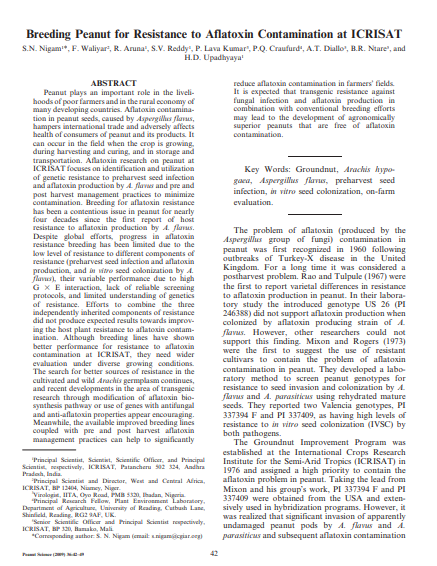Breeding peanut for resistance to Aflatoxin contamination at ICRISAT
Summary
Peanut plays an important role in the livelihoods of poor farmers and in the rural economy of many developing countries. Aflatoxin contamination in peanut seeds, caused by Aspergillus flavus, hampers international trade and adversely affects the health of consumers of peanut and its products. It can occur in the field when the crop is growing, during harvesting and curing, and in storage and transportation. Aflatoxin research on peanut at ICRISAT focuses on the identification and utilization of genetic resistance to preharvest seed infection and aflatoxin production by A. flavus and pre- and post-harvest management practices to minimize contamination. Breeding for aflatoxin resistance has been a contentious issue in peanut for nearly four decades since the first report of host resistance to aflatoxin production by A. flavus. Despite global efforts, progress in aflatoxin resistance breeding has been limited due to the low level of resistance to different components of resistance (preharvest seed infection and aflatoxin production, and in vitro seed colonization by A. flavus), their variable performance due to high G × E interaction, the lack of reliable screening protocols, and limited understanding of the genetics of resistance. Efforts to combine the three independently inherited components of resistance did not produce the expected results and improve the host plant resistance to aflatoxin contamination. Although breeding lines have shown better performance for resistance to aflatoxin contamination at ICRISAT, they need wider evaluation under diverse growing conditions. The search for better sources of resistance in the cultivated and wild Arachis germplasm continues, and recent developments in the area of transgenic research through modification of the aflatoxin biosynthesis pathway or use of genes with antifungal and anti-aflatoxin properties appears to be encouraging. Meanwhile, the available improved breeding lines coupled with pre- and post-harvest aflatoxin management practices can help to significantly reduce aflatoxin contamination in farmers’ fields. It is expected that transgenic resistance against fungal infection and aflatoxin production, in combination with conventional breeding efforts, may lead to the development of agronomically superior peanuts that are free of aflatoxin contamination.
Open resource Download resource Access resource on external site

